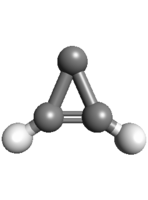|
The transition frequencies were taken from
(1) S. Spezzano, F. Tamassia, S. Thorwirth,
P. Thaddeus, C. A. Gottlieb, and M. C. McCarthy,
2012, Astrophys. J. Suppl. Ser. 200, Art. No. 1.
Predictions with uncertainties larger than 0.3 MHz
should be viewed with caution because of the limited
experimental data. Nevertheless, the data set may well
be sufficient for astronomical observations.
The hyperfine splitting of the two equivalent D
nuclei has been resolved to a large degree in (1).
The hyperfine splitting may be be resolvable in
astronomical observations of cold sources.
Therefore, a separate
hyperfine calculation is provided up to
J = 4 and up to 120 GHz.
The partition function values include the
spin-multiplicity of the two D nuclei.
At lower temperatures, it may be useful to distinguish
between ortho-c-C3D2 and
para-c-C3D2.
The ortho and para levels are described by
Ka + Kc = even
and odd, respectively, with a spin-weight ratio of 2 : 1. The
JKaKc = 101
level is the lowest para state. However, it is
only 1.267823 cm–1 above ground.
Any pronounced effect will likely be restricted to
absorption lines originating in 101.
The dipole moment was assumed to agree with that
of the main species, see e038508.cat.
|
